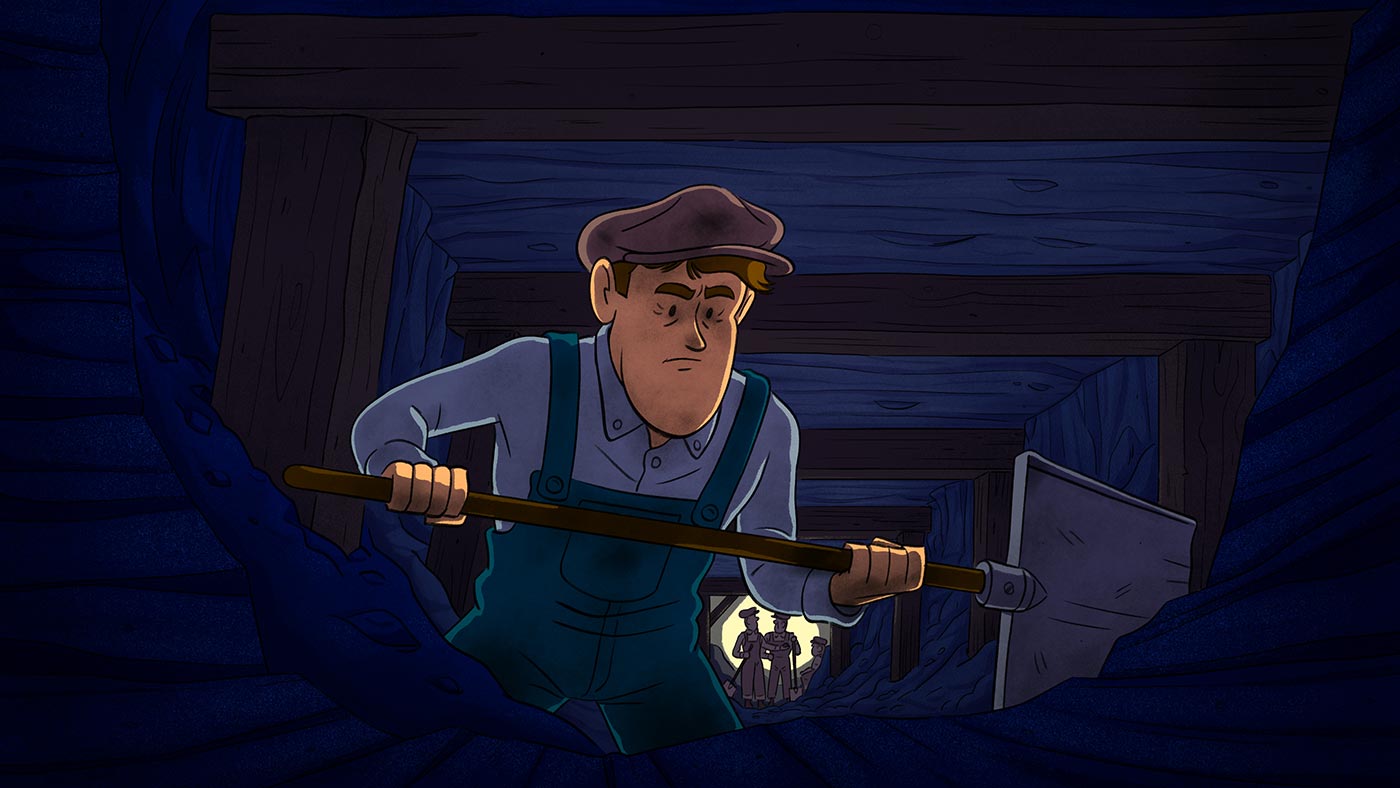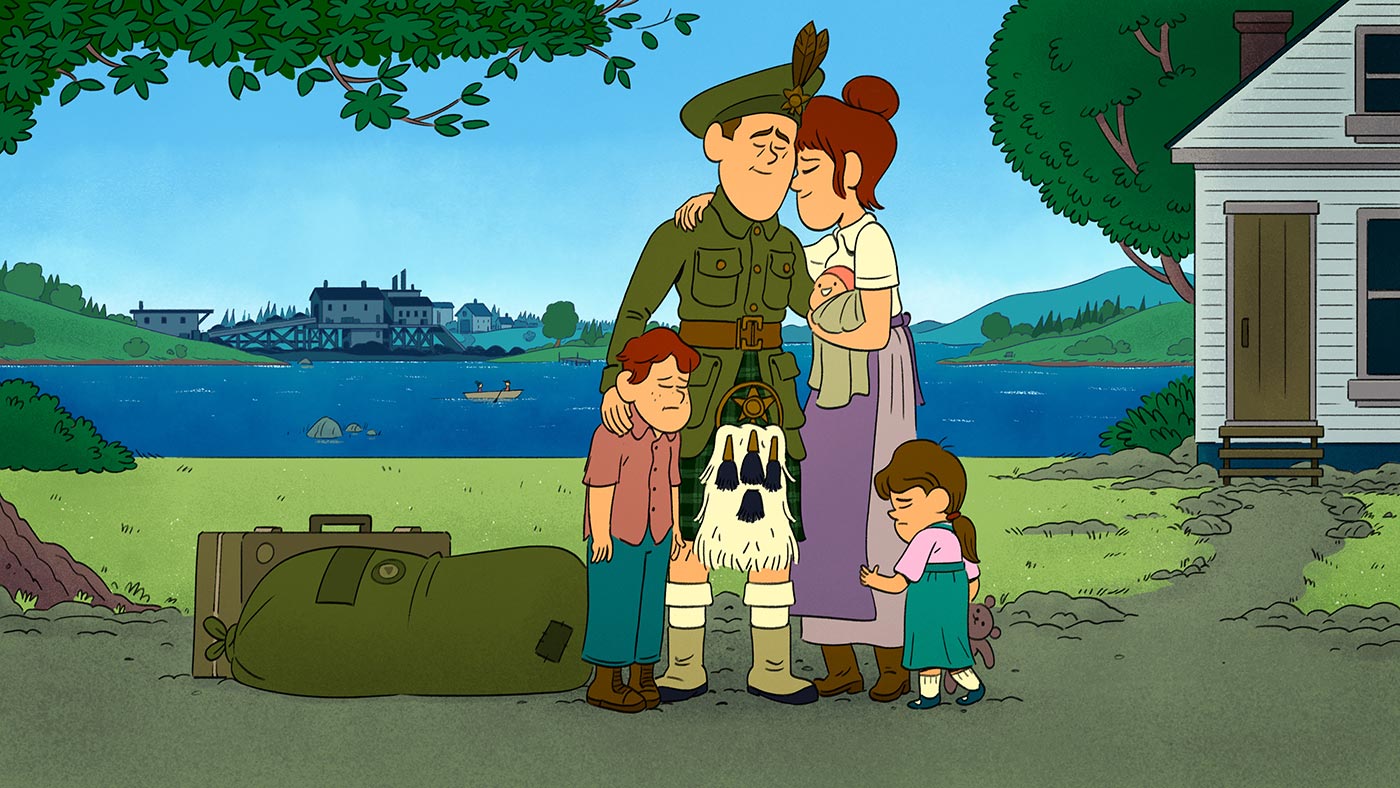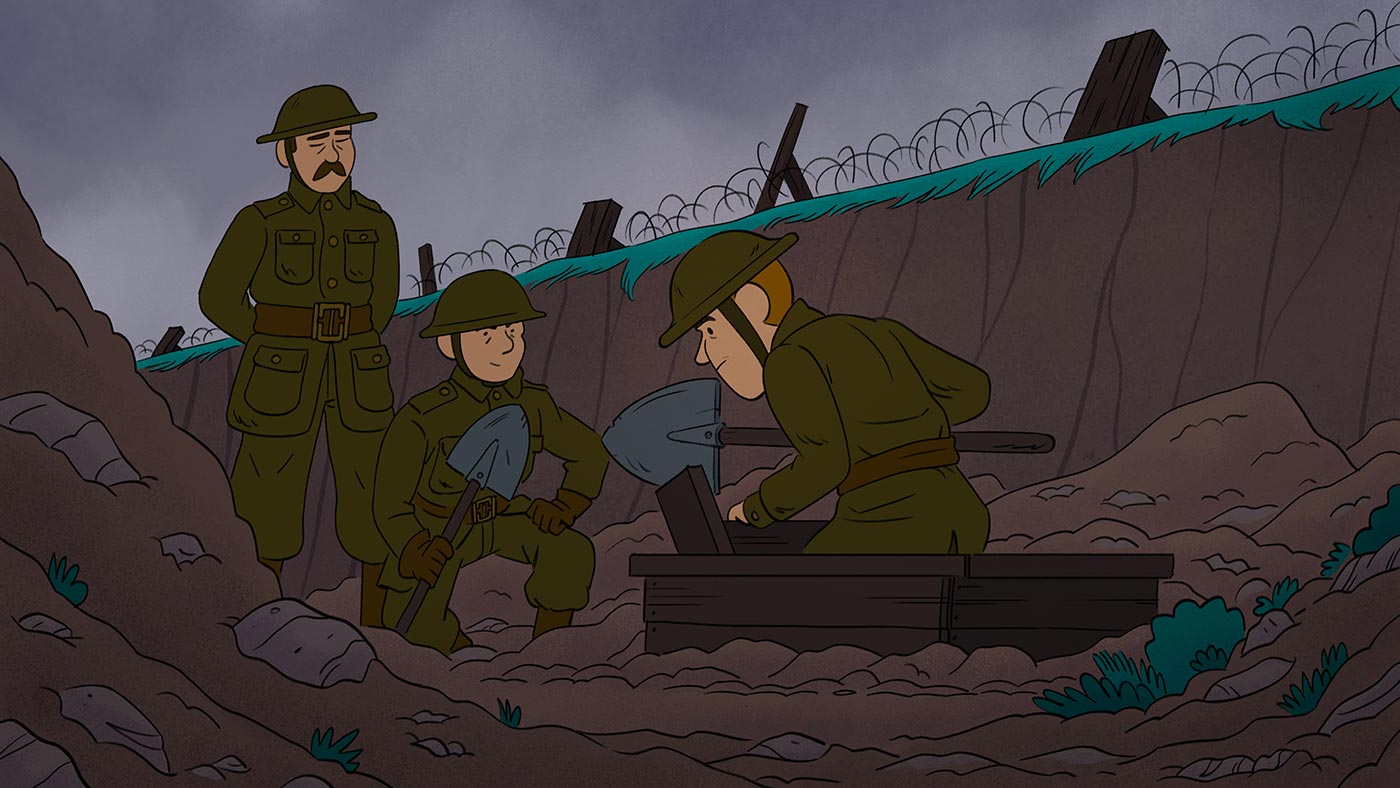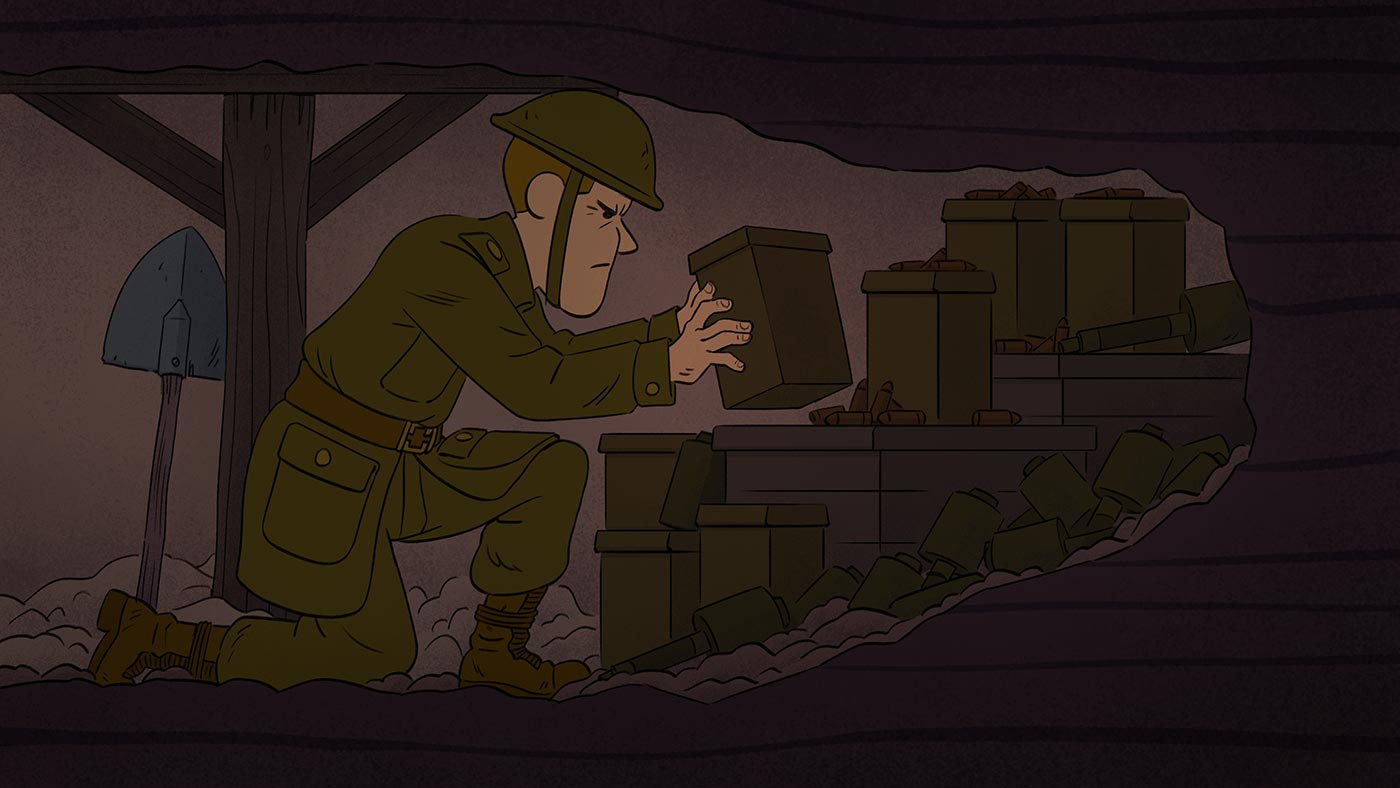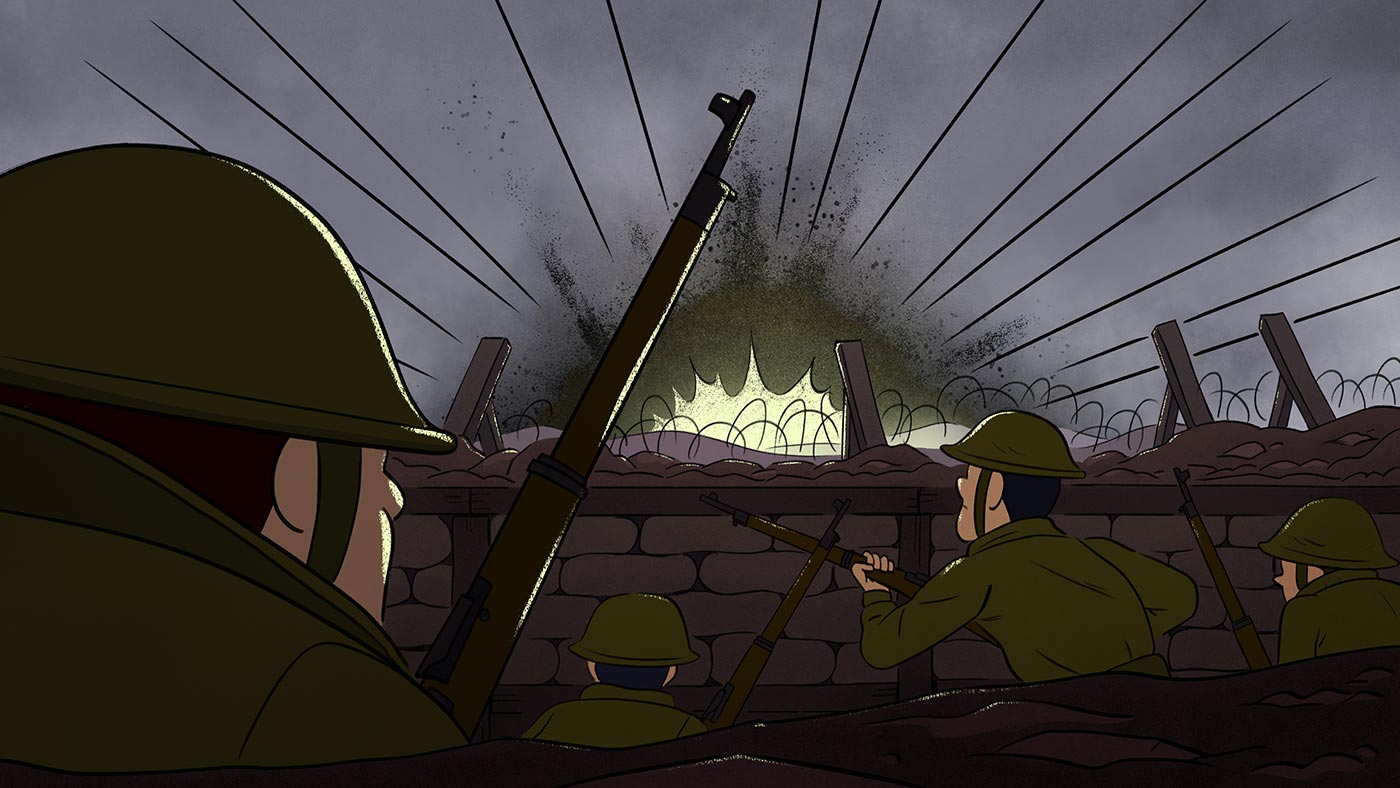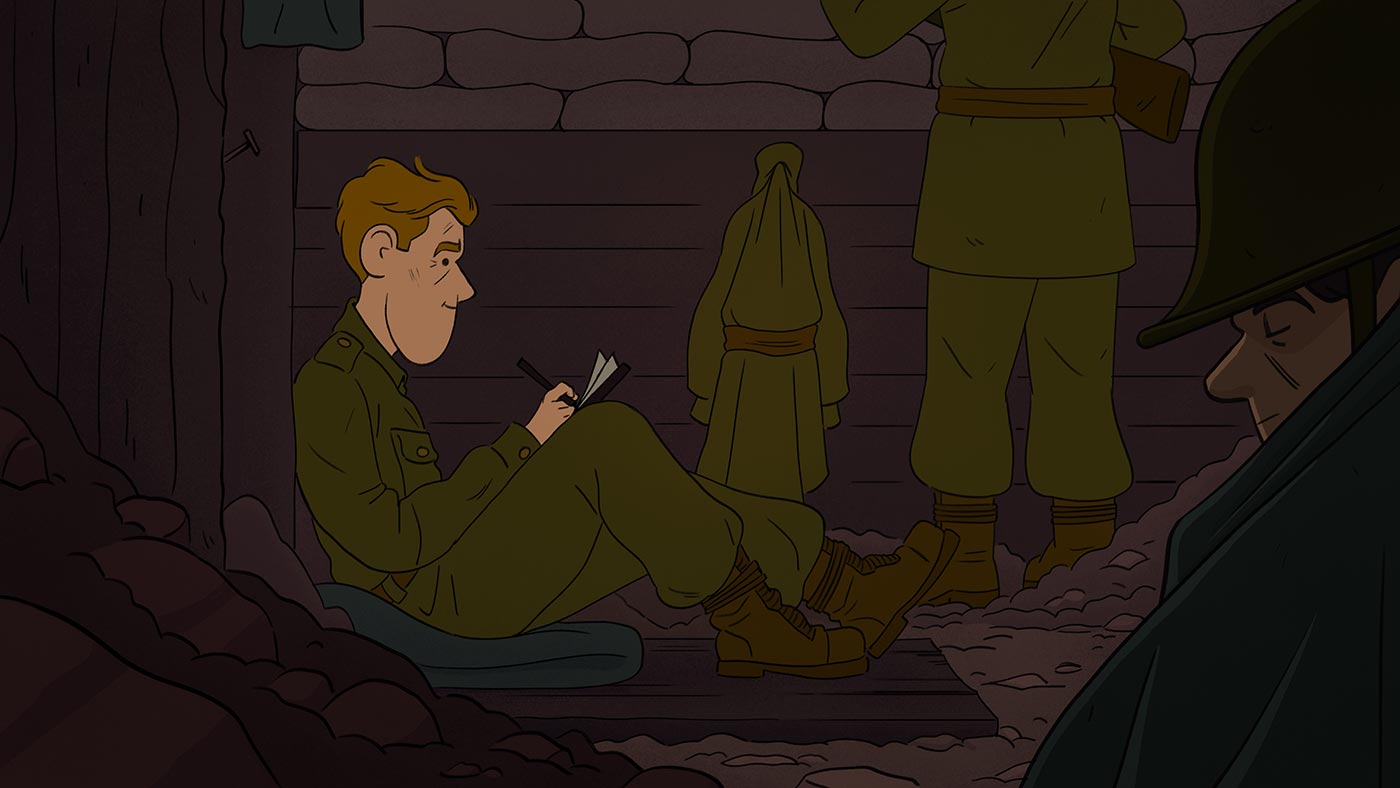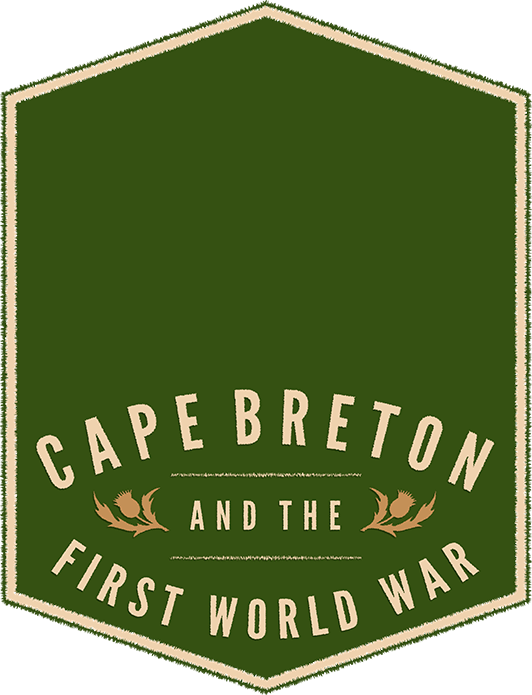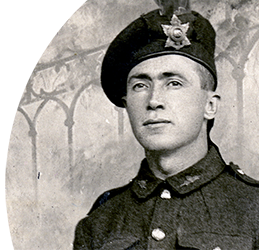Born in Westville, Pictou County in 1883, John Roderick “J.R.” was the son of Roderick “Rory” and Katherine McDougall. Like his father, J.R became a coal miner, and moved to Glace Bay with his parents in 1897 to work at the Dominion No. 3 Colliery. It was the beginning of a 50-year career underground. He married Mary Florence “Minnie” Gillis in 1903, and together they lived at Dominion No. 6 (Donkin) and had 13 children. In August 1916, J.R. enlisted in the 246th Battalion of the Nova Scotia Highland Brigade.
A Life In Photographs
Explore the photograph gallery below to learn more about John Roderick's life and military service.
Bank Head, Dominion No. 6 Colliery, ca. 1920. Over the span of his 50-year career as a miner with the Dominion Coal Company, J.R. worked in the No. 3, No. 4, No. 6, No. 11, and No. 16 mines. A trained shotfirer, he was no stranger to the dangers of his profession... Read Full Caption... View Full Screen Image
Bank Head, Dominion No. 6 Colliery, ca. 1920. Over the span of his 50-year career as a miner with the Dominion Coal Company, J.R. worked in the No. 3, No. 4, No. 6, No. 11, and No. 16 mines. A trained shotfirer, he was no stranger to the dangers of his profession, and lost his left eye in a workplace accident in 1936. (Beaton Institute, Cape Breton University, Reference number: 78-147-1897)
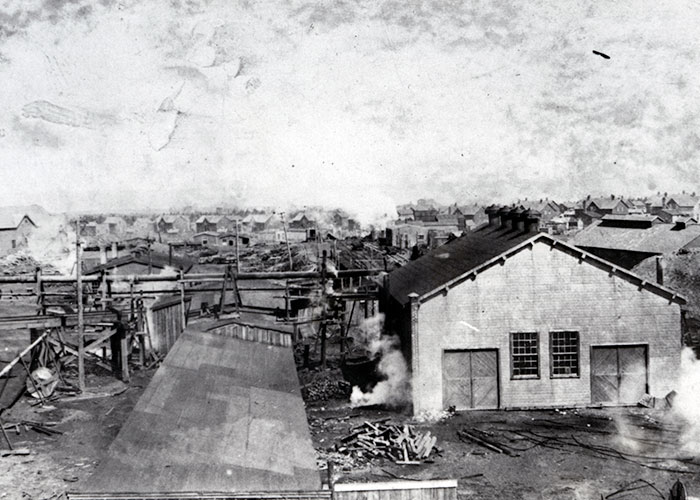
View of Cottages at Coal Mines, Port Hood, ca. 1909. Like many others, J.R. and his brother Duncan McDougall were blacklisted from work in the coal mines in the Glace Bay area in 1909-1910, when the United Mine Workers of America went on strike against the... Read Full Caption... View Full Screen Image
View of Cottages at Coal Mines, Port Hood, ca. 1909. Like many others, J.R. and his brother Duncan McDougall were blacklisted from work in the coal mines in the Glace Bay area in 1909-1910, when the United Mine Workers of America went on strike against the Dominion Coal Company. In need of an income, they went to work at the Port Hood mine, and took up residence in a company house featured in this postcard. (Postcard courtesy of Linda MacDougall Prendergast)

John Roderick McDougall, ca. 1916. J.R. enlisted with the 246th Battalion Nova Scotia Highlanders in August 1916. After several months of training at Camp Aldershot, the Battalion went overseas... Read Full Caption... View Full Screen Image
John Roderick McDougall, ca. 1916. J.R. enlisted with the 246th Battalion Nova Scotia Highlanders in August 1916. After several months of training at Camp Aldershot, the Battalion went overseas and arrived in England in June 1917. (Beaton Institute, Cape Breton University, Reference number: MG 21.15 Robert MacDougall Collection)
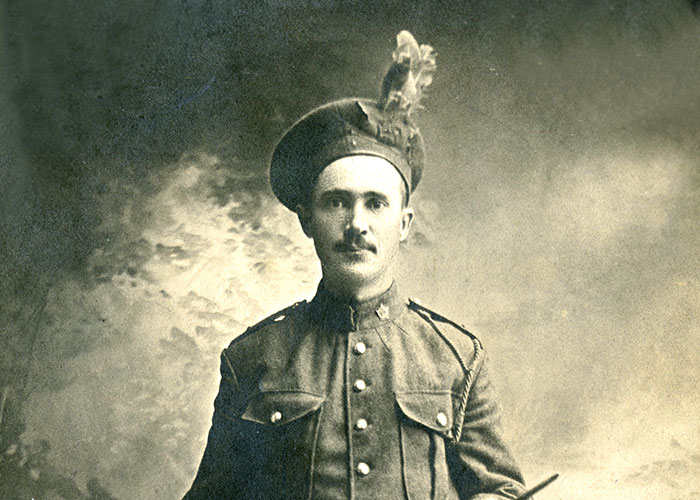
John Roderick McDougall, ca. 1916. (Photograph courtesy of Linda MacDougall Prendergast) View Full Screen Image

John Roderick McDougall, ca. 1917. J.R. was transferred to the 185th Battalion (Cape Breton Highlanders) upon his arrival in England. (Beaton Institute, Cape Breton University, Reference number: MG 21.15 Robert MacDougall Collection) View Full Screen Image
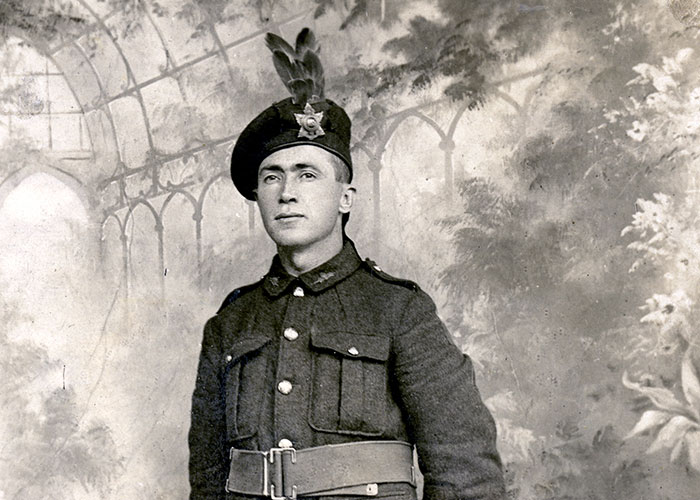
McDougall family at No. 11 Glace Bay, 1917. This photograph of John Roderick's wife Minnie and their 8 children was taken in 1917 while J.R. served overseas. (Photograph courtesy of Linda MacDougall Prendergast) View Full Screen Image
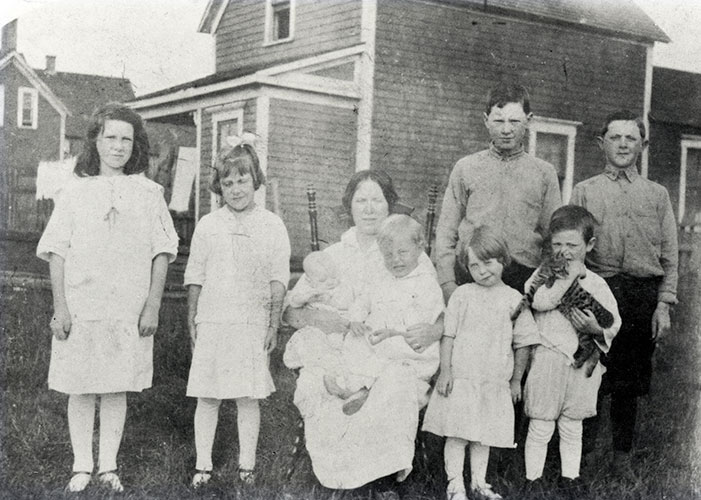
J.R. McDougall and fellow members of the Canadian Military Engineers, Canadian Expeditionary Force, ca. 1918. J.R. (pictured at far right) was posted to No. 3 Tunnelling Company of the Canadian Expeditionary Force in April 1918 and sent to France... Read Full Caption... View Full Screen Image

John Roderick McDougall's paybook, 1918. (Beaton Institute, Cape Breton University, Reference number: MG 21.15 Robert MacDougall Collection) J.R. went to France with No. 3 Tunnelling Company in late April 1918. It was a critical point in the war... Read Full Caption... View Full Screen Image
John Roderick McDougall's paybook, 1918. (Beaton Institute, Cape Breton University, Reference number: MG 21.15 Robert MacDougall Collection) J.R. went to France with No. 3 Tunnelling Company in late April 1918. It was a critical point in the war. The Germans had launched their last massive offensive in March and the Allied forces were in full retreat. No. 3 was working at a furious pace at Hooge, near Ypres, to build networks of trenches behind the Allied lines. When the Germans captured Mount Kemmel on April 26, the situation in the Ypres Salient became untenable. No. 3 TC detonated the demolition charges it had set under the Menin Road (i.e. the road to Ypres) and withdrew from Hooge with no casualties.

John Roderick McDougall and family, 1919. Front, L-R: Isabelle, Minnie, Catherine, Kenneth, Mrs. Catherine (Thompson) McDougall, Robert. Back, L-R: John, Joseph, John Roderick, Ranald. J.R. and his wife Minnie had 13 children, but not all survived... Read Full Caption... View Full Screen Image
John Roderick McDougall and family, 1919. Front, L-R: Isabelle, Minnie, Catherine, Kenneth, Mrs. Catherine (Thompson) McDougall, Robert. Back, L-R: John, Joseph, John Roderick, Ranald. J.R. and his wife Minnie had 13 children, but not all survived and the family suffered several tragedies. Infant sons Roderick and Angus died several years before the war. They lost two daughters while J.R. served in England: 5-month-old Mary Cecelia to cholera infantum in October 1917, and 11-year-old daughter Elizabeth to tubercular meningitis in March 1918. Fifteen-year-old son Kenneth died of diabetes in 1930, and three other daughters, Mary Catherine, Mary Isabelle, and Elizabeth all died as young adults. Minnie died of influenza in 1933, aged 52. (Photograph courtesy of Linda MacDougall Prendergast)

John Roderick and wife Minnie with sons Duncan and Robert and daughter Elizabeth, 1925. (Photograph courtesy of Linda MacDougall Prendergast) View Full Screen Image
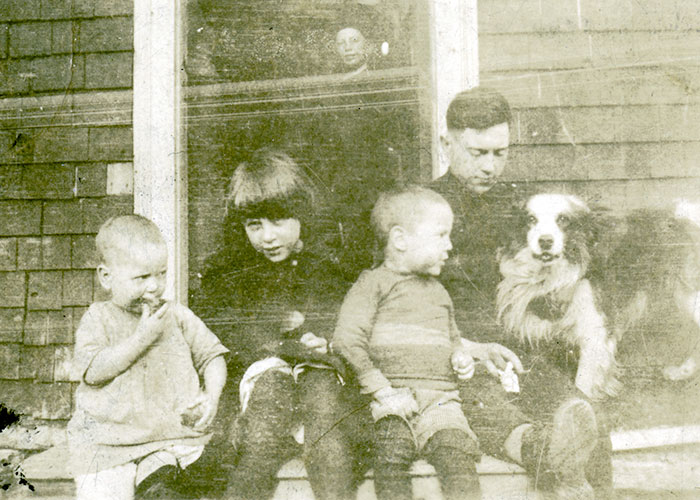
John Roderick and wife Minnie with sons Duncan and Robert and daughter Elizabeth, 1925. (Photograph courtesy of Linda MacDougall Prendergast) View Full Screen Image
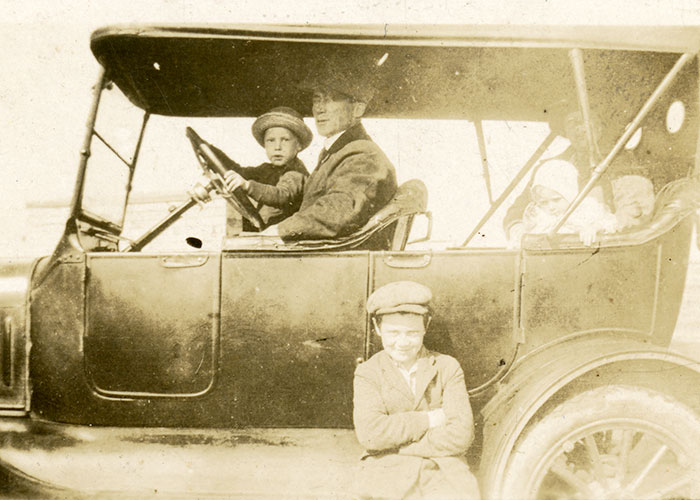
John Roderick McDougall and son Ranald, ca. 1939-1945. (Photograph courtesy of Linda MacDougall Prendergast) View Full Screen Image
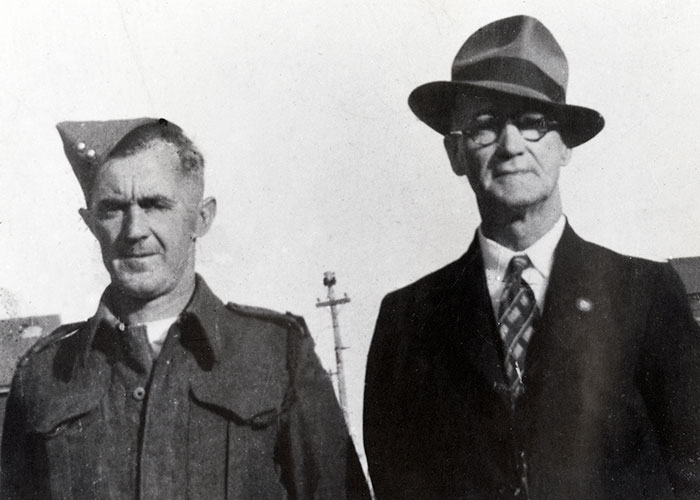
John Roderick at the Cenotaph in Donkin, ca. 1946. Following the war, J.R. joined the Dominion No. 6 branch of the Great War Veterans Association, a precursor to the Canadian Legion. He served as president of the Branch 5 Royal Canadian Legion... Read Full Caption... View Full Screen Image
John Roderick at the Cenotaph in Donkin, ca. 1946. Following the war, J.R. joined the Dominion No. 6 branch of the Great War Veterans Association, a precursor to the Canadian Legion. He served as president of the Branch 5 Royal Canadian Legion in Donkin in 1946. (Photograph courtesy of Linda MacDougall Prendergast)

Canadian soldiers walk the streets of Kinmel, inspecting damage following the riots in March 1919. J.R. was awaiting transportation back to Canada when a major riot took place at Kinmel Park on March 4, 1919. Men protested the long delay in their return home... Read Full Caption... View Full Screen Image
Canadian soldiers walk the streets of Kinmel, inspecting damage following the riots in March 1919. J.R. was awaiting transportation back to Canada when a major riot took place at Kinmel Park on March 4, 1919. Men protested the long delay in their return home, and the appalling living conditions that winter. The situation was made worse by the arrival of the Spanish Flu, which struck hundreds of men (and some nurses at the camp hospital). Five men were killed and another 23 were wounded in the riot. Among those killed was 18-year-old David Gillan, a miner from Florence, Cape Breton County. (Photograph from the George Metcalf Archival Collection, Canadian War Museum, CWM0020051-007.)
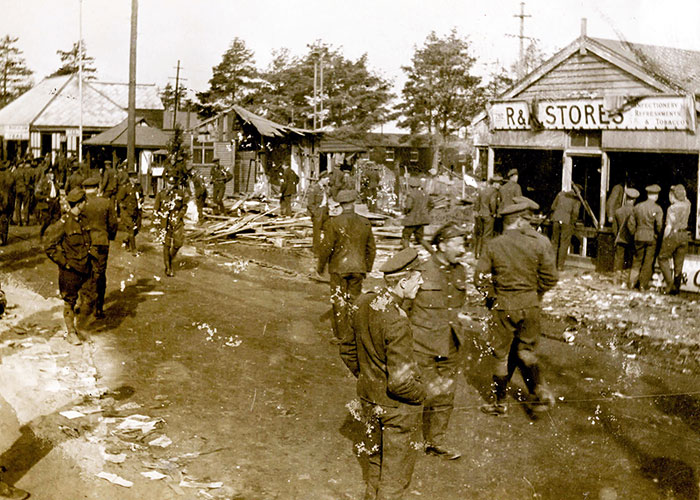
The Fight Beneath The Surface

J.R. McDougall and fellow members of the Canadian Military Engineers, Canadian Expeditionary Force, ca. 1918.
Most men who served in the Canadian Expeditionary Force (CEF) in the First World War served in the infantry (foot soldiers) or artillery (weapons). Others served in various support units, including engineers, labour battalions, ammunition columns, service units, as well as doctors and nursing sisters in the Canadian Army Medical Corps. A small number also served in tunnelling companies, which were attached to the Royal Canadian Engineers.
The onset of static trench warfare in the autumn of 1914 created a need for new tactics in the battlefields of the Western Front. Beneath the surface, underground tunnels were dug by both the Allies and the Central Powers below enemy positions to destroy their defences and advance their offences. Northeastern France and western Belgium, where much of the fighting took place, was already a major coal-mining region, and its soil conditions were ideal for mining. By early 1915 both sides were mining and counter-mining intensively.
Men employed in tunnelling companies (called tunnellers or sappers) often performed difficult, dangerous, and highly-skilled work. Experienced miners from Australia, Britain, Canada, and New Zealand were recruited to fight this subterranean war, their efforts largely overlooked but still etched in the landscape today. Of the hundreds of Canadian men who served in this role, approximately 200 were from Cape Breton. John Roderick McDougall of Donkin was one.
“YOU AND I WILL LIVE HAPPY TOGETHER YET.”
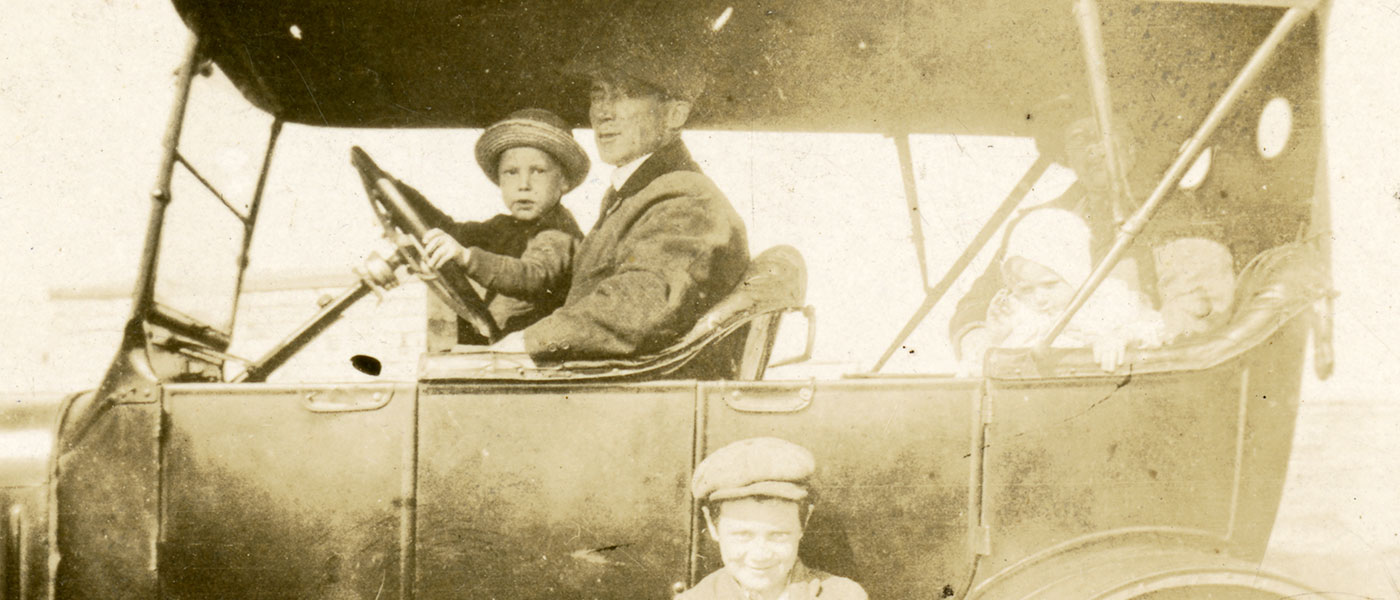
John Roderick and wife Minnie with sons Duncan and Robert and daughter Elizabeth, 1925.
"Anyway, be good to the children and to yourself. You and I will live happy together yet." -J.R. McDougall to Minnie McDougall
John Roderick was 33 when he enlisted with the 246th Battalion, with 8 children at home. He went to Camp Aldershot, on the outskirts of Kentville, Nova Scotia, for basic training before sailing overseas aboard the S.S. Olympic in June 1917. Once in England, he was transferred to the 185th Battalion (Cape Breton Highlanders). He was then posted to No. 3 Tunnelling Company of the Royal Canadian Engineers in April 1918, and sent to France.
J.R.’s time at the Front was brief. He served in the field until October 1918, when he was hospitalized at Boulogne with a hernia. By the time he recovered, the war was over, and he was sent to the Canadian repatriation camp at Kinmel Park in Wales to await transportation back to Canada. He was present, though apparently not involved, in the Kinmel Park riot on March 4, 1919, and sailed to Halifax several days later.
Following the war, John Roderick resumed his career as a miner with the Dominion Coal Company. He worked in several mines in the greater Glace Bay area, including Passchendaele, Caledonia, Donkin, and New Waterford. Despite losing his left eye in a workplace accident in 1936, he continued to mine until his retirement in 1947. He died in 1957, aged 75.
Library and Archives Canada, Personnel Records of the First World War. "McDougall, J.R.," RG 150, Accession 1992-93/166, Box 6788 — 25, page 1. View Full Screen Image
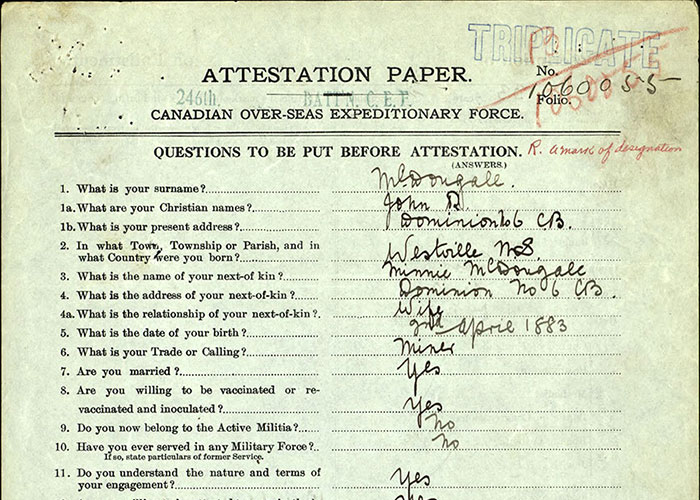
Library and Archives Canada, Personnel Records of the First World War. "McDougall, J.R.," RG 150, Accession 1992-93/166, Box 6788 — 25, page 5. View Full Screen Image
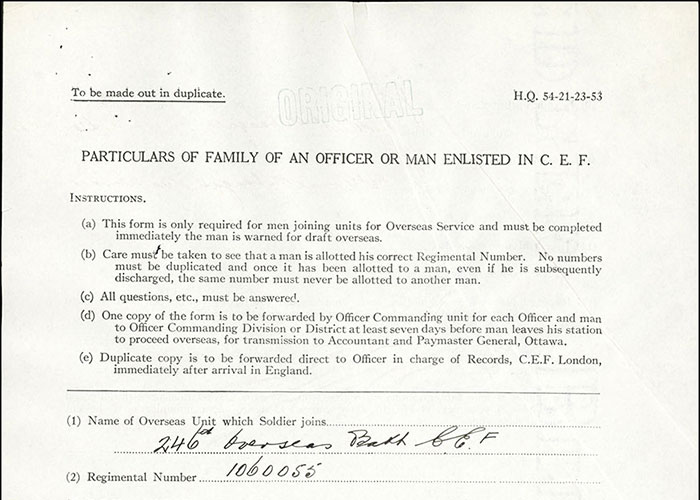
Library and Archives Canada, Personnel Records of the First World War. "McDougall, J.R.," RG 150, Accession 1992-93/166, Box 6788 — 25, page 9. Read Full Caption... View Full Screen Image
Library and Archives Canada, Personnel Records of the First World War. "McDougall, J.R.," RG 150, Accession 1992-93/166, Box 6788 — 25, page 9. Like so many men and women who served, J.R. spent much of his time battling illness while overseas. After suffering multiple bouts of influenza, a hernia later prevented him from returning to the Front. His case is but one example of the public health crisis spurred on by the conflict, in which injury, disease, and death were common occurrences with far-reaching effects.

Library and Archives Canada, Personnel Records of the First World War. "McDougall, J.R.," RG 150, Accession 1992-93/166, Box 6788 — 25, page 19. View Full Screen Image

Library and Archives Canada, Personnel Records of the First World War. "McDougall, J.R.," RG 150, Accession 1992-93/166, Box 6788 — 25, page 21. View Full Screen Image
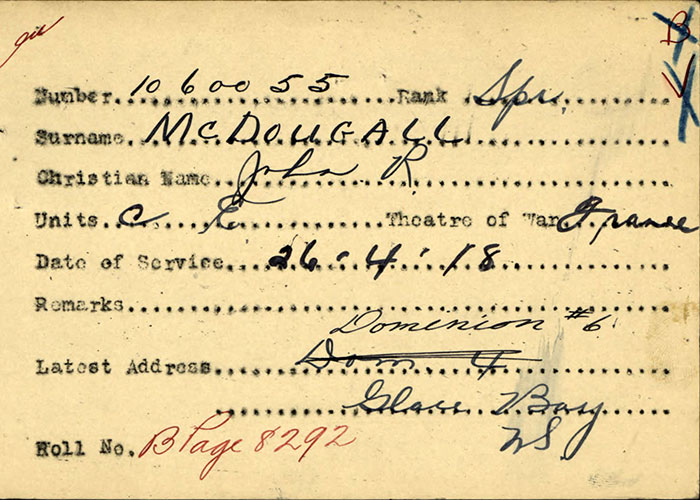
Library and Archives Canada, Personnel Records of the First World War. "McDougall, J.R.," RG 150, Accession 1992-93/166, Box 6788 — 25, page 1. View Full Screen Image
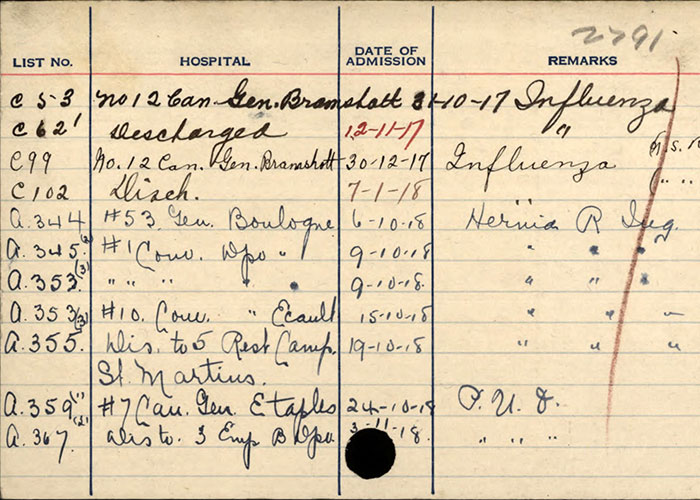
Canada's Subterranean Soldiers

Mine, Glace Bay, 1905. (Beaton Institute, Cape Breton University, Reference number: 80-18-4198)
The CEF established four tunnelling companies during the war, three of which served in France: No. 1 was organized in September 1915 and recruited miners already serving overseas in infantry battalions, supplemented by men recruited in mining communities in eastern Canada; No. 2 was also organized in September 1915 and recruited in mining communities in Alberta and British Columbia; No. 3 was organized at Bailleul, France, in December 1915 and was formed by absorbing the brigade mining sections of the 1st and 2nd Canadian Divisions. No. 4 Canadian Tunnelling Company was organized in March 1916 and recruited miners in western Canada. It did not go to France, but remained in England as a reserve unit to provide reinforcements to the other companies.
Tunnelling was extremely dangerous work that involved heavy labour and required the knowledge and expertise of men who could cope with the psychological effects of working underground. As a result, almost all tunnellers were recruited from mining communities. Although precise figures are not known, as many as 1,100 men may have served in the Canadian tunnelling companies.
The Cape Breton Coal Miners

Donkin Miners, ca. 1925. (Beaton Institute, Cape Breton University, Reference number: 86-68-16165)
Because Cape Breton was one of the major coal mining regions in Canada, approximately 200 men from communities all over the Island were recruited, transferred, or enlisted to serve as tunnellers, including Francis Saccary of Bridgeport, Archibald Pilley of Caledonia, Arsene “Archie” Cormier of Cheticamp, Nicholas Kennedy of Dominion, Vincent McDonald of George’s River, John Angus McNeil of Inverness, Walter Butts of Lingan, Thomas Ling of New Aberdeen, Hector Ross of Northeast Margaree, and Daniel Currie of Reserve Mines.
In late December 1918, Field Marshal Earl Haig commended Canada’s tunnellers for their important contributions to the Allied victory. Also recognized was the success of six miners from Caledonia, all members of the 1st Canadian Tunnelling Company, for winning first-prize and setting a world record in an international sapping contest.
Under Enemy Lines

Ordnance Survey map, France, August 20, 1918. (Beaton Institute, Cape Breton University, Reference number: MAP 205)
Tunnelling companies dug tunnels where explosives were placed, but they also constructed subways, cable trenches, saps and underground chambers for signal or medical services. In suitable locations, extensive networks of tunnels were dug behind the front lines, allowing for the movement of men and supplies into the front trenches without enemy detection.
Tunnellers worked in extremely difficult conditions underground, in cold, dark, wet, poorly ventilated and confined spaces. Digging was done by candlelight and in near silence to prevent any chance of revealing their location to the Germans. Careful listening, often using geophones (acoustic detection device) was also required to detect enemy activity and movement.
Subterranean warfare was extremely dangerous, because explosions, flooding, and collapses posed a daily threat. Unexpected encounters with German tunnellers (called Pionere) were also possible, and many men lived in fear of sudden death from asphyxiation, drowning, entombment, and explosions.
Mines tunnelled under enemy lines played a key role in several battles. On March 27, 1916, six mines were detonated under German positions close to Messines, near Ypres, Belgium. The largest was dug by No 1 Canadian Tunnelling Company at St Eloi and involved 43,400 kg of explosives. The resulting explosion initiated the Battle of St Eloi, one of the more chaotic battles of the war, in which the 25th Battalion (Nova Scotia Rifles) fought its first battle.
The Somme offensive, one of the most brutal and bloody of the war, also began with the explosion of mines. On the morning of July 1, 1916, several explosive charges laid by British tunnellers were detonated beneath German positions along the Hawthorn Ridge, near Beaumont Hamel. The attack that followed was a catastrophic loss for the Allies in which the 1st Newfoundland Regiment was nearly decimated.
In preparation for the Battle of Vimy Ridge, tunnelling companies dug an astonishing 20 kilometres of subways for foot traffic, tramways equipped with rails for moving ammunition to the front lines and evacuating wounded soldiers, and light railways—all concealed from the Germans. The tunnelling network at Vimy Ridge housed 24,000 men prior to the attack (April 9, 1917) and was equipped with electric lighting, kitchens, latrines and a medical centre. A 250-metre section has been preserved and is accessible to the public, in recognition of the pivotal role which the tunnelling companies played in the Canadian victory at Vimy Ridge.
In the months leading up to the Battle of Messines, Allied tunnellers laid 25 massive mines charged with several hundred thousand kilograms of explosives under the German-occupied Messines ridge. They were detonated on the morning of June 7, 1917, resulting in an enormous explosion that killed 10,000 German soldiers. The 1st and 3rd Canadian Tunnelling Companies were involved in the preparation for and execution of the explosion, including electrician turned Sergeant Daniel “Danny” Lynk of Glace Bay, who was awarded the Military Medal for his actions during the battle.
Following the summer of 1917, the war became more mobile and underground warfare diminished. Tunnelling personnel were assigned to other engineering or infantry units, while some continued to work on underground subways and shelters for frontline infantry. During the German offensive in the spring of 1918, several tunnelling units were called upon to serve as infantry. When that offensive failed and the Allies began their final push against the Germans, tunnelling companies worked to make safe captured towns, villages and facilities, including the very dangerous work of clearing tunnels of the many enemy explosives left behind.
Cape Breton's Industrial Role in the War
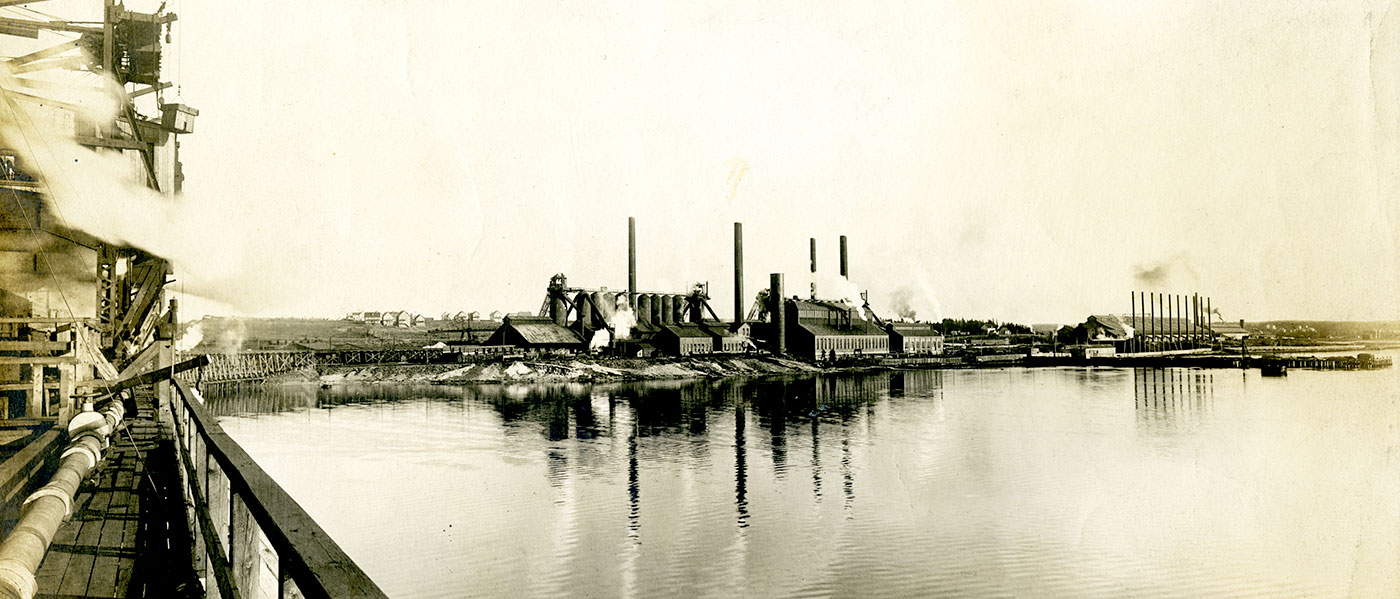
Dominion Iron and Steel Company Plant from Sydney Harbour, ca. 1900. (Beaton Institute, Cape Breton University, Reference number: 77-620-754)
In the summer of 1914 Canada was in an economic recession. High unemployment led many men to join the militia in the year before the war or enlist for service soon after it began. But the outbreak of war, and government orders for a range of military materials – from steel and coal to uniforms and food supplies – quickly stimulated the economy.
The onset of this massive government wartime spending benefitted all sectors, but heavy industry was especially impacted, particularly in Cape Breton. At the time, Sydney and its surrounding communities comprised one of the most significant industrial regions in Canada. Two steel plants – one in Sydney, the other in Sydney Mines – received large orders for ingots to be processed into artillery shell casings, which by mid-1916 produced more than 40,000 tons together per month.
Coal mines in the area were bolstered too, as coal was the main source of fuel for the steel plants, as well as many merchant ships that sailed from Sydney Harbour to Britain with vital cargoes to maintain the war effort. Dominion Steel also became the primary producer of trinitrotoluol, a by-product from its coke ovens which was converted into TNT, the explosive used in artillery shells. By the end of the war it had produced more than 3 million litres, which were converted into 19 million kilograms of TNT. Agriculture, forestry and fishing also thrived during the war.
Not all economic effects were positive, however. Because so many men had enlisted for military service, a labour shortage soon developed on the Homefront. Women were hired to fill the gap at the steel plants, but their lower wages alarmed male steelworkers. They were also blocked from working in the coal mines, which caused a decline in production and shortage of an essential product. The thriving economy created inflation, and although prices rose throughout the war, wages did not keep pace. The result was growing labour unrest, and by the end of the war and throughout the 1920s, the industrial area was plagued by conflict, plant and mine closures, and serious economic depression.
